Substitute for Fresh Figs
When you need to replace fresh figs in a recipe, you've got several reliable options. Dried figs offer the closest flavor match, though you'll want to soak them in warm water for 20-30 minutes to restore their texture. Medjool dates work well as a substitute, providing similar sweetness and texture, but use slightly less due to their concentrated flavor. Fresh pears can effectively replace figs in salads and desserts, while fig jam serves as an excellent alternative in sauces and spreads. For baked goods, dried apricots or prunes can step in, offering comparable sweetness and moisture content. Each substitute brings its own unique characteristics that can enhance your culinary creations in different ways.
This post may contain affiliate links. If you make a purchase through these links, I may earn a commission at no additional cost to you. Additionally, portions of this post may be generated using artificial intelligence (AI) technology. While we strive for accuracy, please be aware that AI-generated content may not always be perfect and should be fact-checked when necessary.
The Spatula Scoops
- Dried figs offer the closest flavor match, using a one-to-one replacement when soaked in warm water for 20-30 minutes.
- Fig jam or preserves provide similar taste profiles and can be used in equal quantities, though sweetness may need adjustment.
- Medjool dates work well as substitutes due to their natural sweetness and caramel notes, but use less to avoid oversweetening.
- Fresh pears deliver comparable juiciness and texture, making them ideal replacements in both salads and desserts.
- Dried apricots provide a sweet-tart flavor and chewy texture that closely mimics figs in most recipes.
Understanding Fresh Fig Alternatives

Fresh fig substitutes can transform your recipes when the real thing isn't available. When you're looking to replace fresh figs in your cooking or baking, you'll find several reliable alternatives that can deliver similar results. You can also creatively enhance your dishes by incorporating unique flavors, such as those found in festive desserts and drinks. Understanding these options will help you make informed choices for your specific culinary needs.
Dried figs are your most straightforward substitute, offering an intensified sweetness and chewy texture that works perfectly in a one-to-one replacement ratio. You'll find that Medjool dates can step in admirably, bringing their natural sweetness and caramel notes to your dishes, though you'll notice a slightly different texture. For recipes where moisture content matters, fresh pears can serve as your go-to substitute, providing comparable juiciness despite their firmer consistency. When you're seeking concentrated sweetness, prunes work well in equal measurements, though they'll introduce a distinct tangy element to your dish. For the closest approximation of fresh fig flavor, you might want to contemplate fig jam or preserves, which you can use in matching quantities and will integrate seamlessly into most recipes requiring fresh figs.
Dried Fruit Substitutes
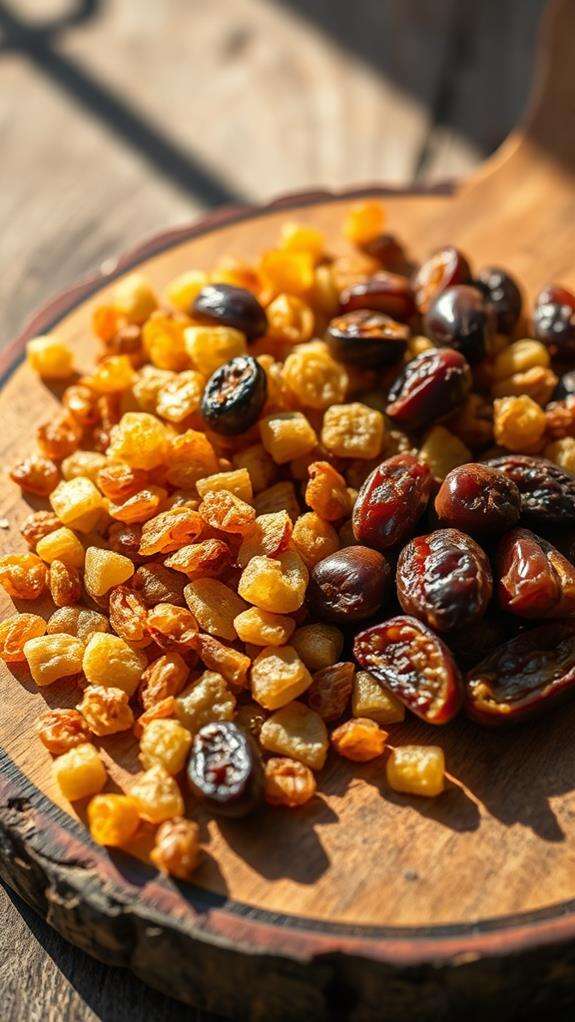
Several dried fruits can effectively stand in for figs when you're following a recipe. These alternatives not only offer similar sweetness and texture profiles but also add unique flavor dimensions to your dish. You'll find that dried alternatives offer similar sweetness and texture profiles, though you'll need to adjust the amount of dried fruit you use to prevent overwhelming your dish's flavor balance. When selecting your dried fruit substitute, consider these reliable options:
- Dried apricots provide a sweet-tart flavor and chewy texture that closely mirrors figs.
- Dried plums (prunes) deliver natural sweetness with a juicy profile.
- Dried dates offer intense sweetness, perfect for purees and natural sweetening.
You'll want to use less of these substitutes than the recipe calls for fresh figs, as dried fruit contains concentrated sugars. For example, if your recipe requires one cup of fresh figs, start with 2/3 cup of dried alternatives and adjust to taste. Dried peaches and nectarines work particularly well in baked goods and desserts, maintaining both texture and sweetness levels similar to figs. When working with dates as a substitute, remember they're excellent for blending into purees but won't provide the signature crunch you'd get from fig seeds. For other easy recipe ideas, check out skinny recipes.
Best Seasonal Replacements
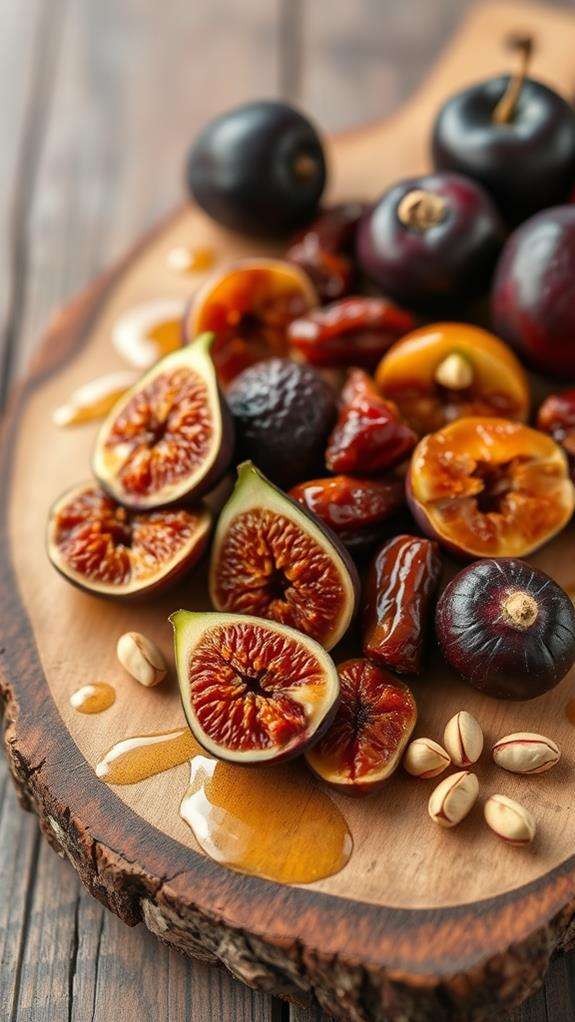
Throughout the year, you'll find various seasonal fruits that can seamlessly replace fresh figs in your recipes. When selecting fresh fruit alternatives, it's important to contemplate both texture and flavor profiles to achieve the best results in your dishes. For instance, rendered beef fat can enhance flavors in recipes, similar to how fresh fruits can elevate a dish culinary uses of tallow.
During summer months, you can rely on fresh peaches and nectarines as your go-to substitutes for figs. These fruits offer similar sweetness levels and maintain that sought-after tender, juicy consistency. As you shift into late summer and early fall, plums become an excellent option, particularly in salads and dessert preparations. When autumn arrives, you'll want to turn your attention to fresh pears, which provide a mild sweetness that works wonderfully in both sweet and savory applications. For holiday cooking and baking, think about fresh cranberries, especially when you're preparing savory dishes that call for figs. While cranberries offer a more tart profile than figs, they'll bring a complementary brightness to your seasonal recipes. Remember to adjust any added sweeteners in your recipes when switching between these fresh fruit alternatives, as their natural sugar content varies considerably.
Cooking With Fig Alternatives
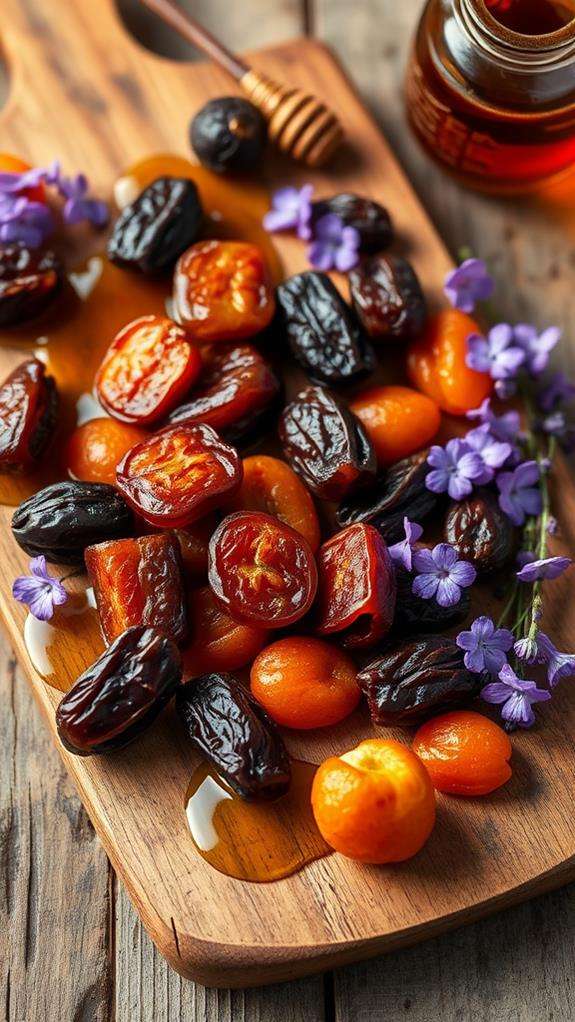
When adapting recipes that call for fresh figs, you'll need to make specific adjustments based on your chosen substitute. If you're working with dried figs, use them in equal measurements but remember they'll pack more sweetness into your dish. You'll want to soak them in warm water for 15-30 minutes before use to achieve a texture closer to fresh figs.
For a sophisticated approach to fig substitution, contemplate these tested alternatives:
- Roast grapes at 400 degrees for 20 minutes to create a concentrated sweetness that works particularly well on cheese boards
- Use fresh pears as a lighter alternative in salads and desserts, matching the juicy texture of figs
- Incorporate fig jam in equal portions when you need the distinct fig flavor in sauces or toppings
When you're cooking with these alternatives, you'll need to reflect on the moisture content of your substitute. For instance, roasted grapes will release more liquid than fresh figs, so you might want to drain them slightly before adding to your recipe. If you're using fig jam, reduce other sweet ingredients in your recipe to maintain the right balance of flavors.
Sweet and Savory Options
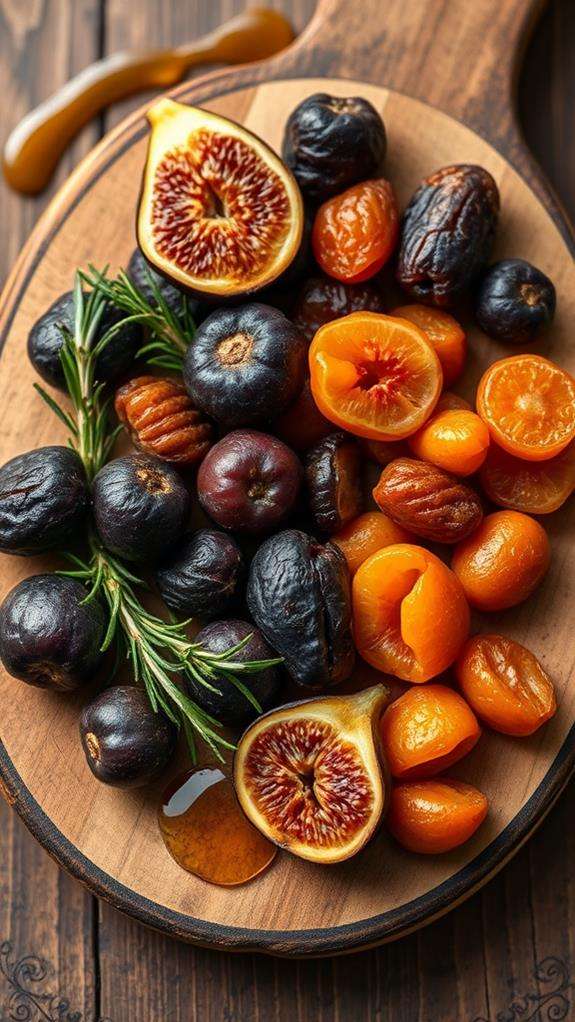
The versatility of fig substitutes spans both sweet and savory applications, giving you multiple options for your culinary creations. When you're looking for sweetness, dried figs offer a concentrated flavor that works beautifully in baked goods and salads, while Medjool dates provide a rich, caramel-like sweetness that's perfect for both desserts and savory dishes.
For a balance of sweet and tart flavors, you'll find dried apricots particularly useful in tarts and other desserts where you'd typically use fresh figs. In savory applications, you can pair pears with strong cheeses like Gorgonzola to recreate the classic fig-and-cheese combination that's so popular in Mediterranean cuisine. When you're assembling cheese platters or seeking a sophisticated snack option, consider roasted black grapes drizzled with honey as your fig alternative. They'll provide that same juicy sweetness that makes figs so appealing.
Each of these substitutes brings its own unique characteristics to your dishes while maintaining the essential sweet-savory balance that makes fresh figs so versatile in cooking.
Dried Fig Preparation Methods
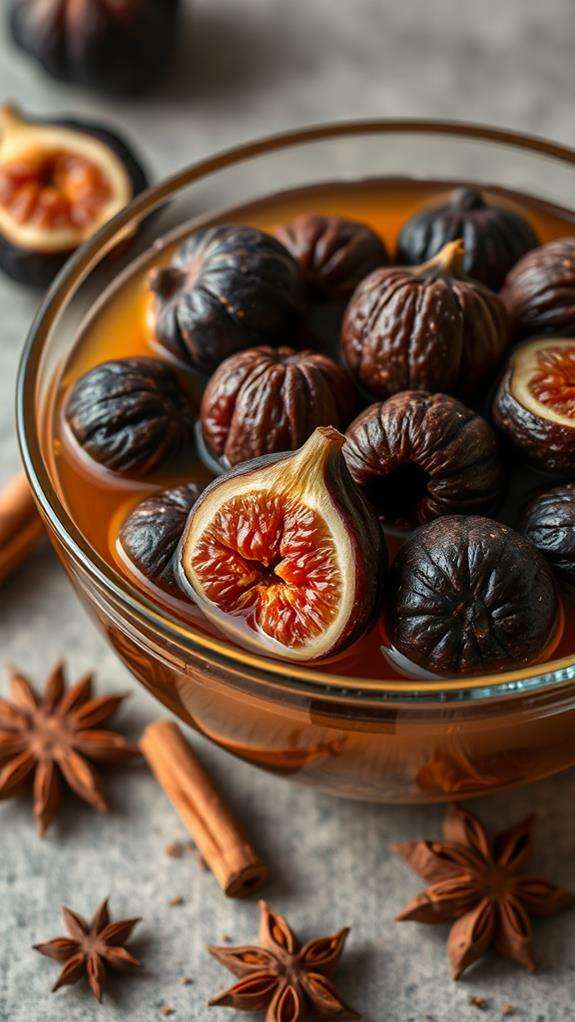
Several preparation techniques can transform dried figs into versatile ingredients that closely mimic fresh ones. You'll find that rehydrating dried figs in warm water or fruit juice for 30 minutes can restore their plump texture and make them more similar to their fresh counterparts. When you're working with dried figs, remember that they're more concentrated in flavor, so you'll want to use about one-third of the amount compared to fresh figs in your recipes.
Here are essential preparation methods you can use to maximize dried figs' potential:
- Simmer chopped dried figs in sauces or soups to infuse their natural sweetness throughout your dish
- Finely chop them before adding to baked goods like cookies or bread for even distribution
- Dice and briefly soak them in vinegar or citrus dressing before adding to salads
For best results in cooking, you'll want to take into account the specific application of your dried figs. When baking, the fine chopping method helps prevent clumping and guarantees consistent sweetness throughout your creation. If you're making sauces, allowing the figs to simmer will create a more complex flavor profile.
Nutritional Value Comparison

Understanding the nutritional differences between fresh and dried figs can help you make informed choices for your dietary needs. When you're comparing these options, you'll notice that fresh figs are considerably lower in calories, containing about 74 calories per 100 grams, while dried figs pack a denser 249 calories for the same amount.
If you're focusing on fiber intake, both varieties are excellent choices. Fresh figs provide 3.1 grams of fiber per 100 grams, while dried figs offer slightly more at 3.7 grams. You'll get more concentrated nutrients from dried figs, particularly minerals like calcium and potassium. However, if you're watching your sugar intake, you'll want to stick with fresh figs, as the drying process concentrates the natural sugars considerably. When it comes to vitamins, fresh figs have the upper hand, delivering a broader spectrum of nutrients including vitamins A, B, and K. While both types contain beneficial antioxidants called polyphenols, you'll find higher concentrations in dried figs due to the dehydration process. If you're counting calories but still want the nutritional benefits, fresh figs are your better option.
Recipe Adjustments and Tips
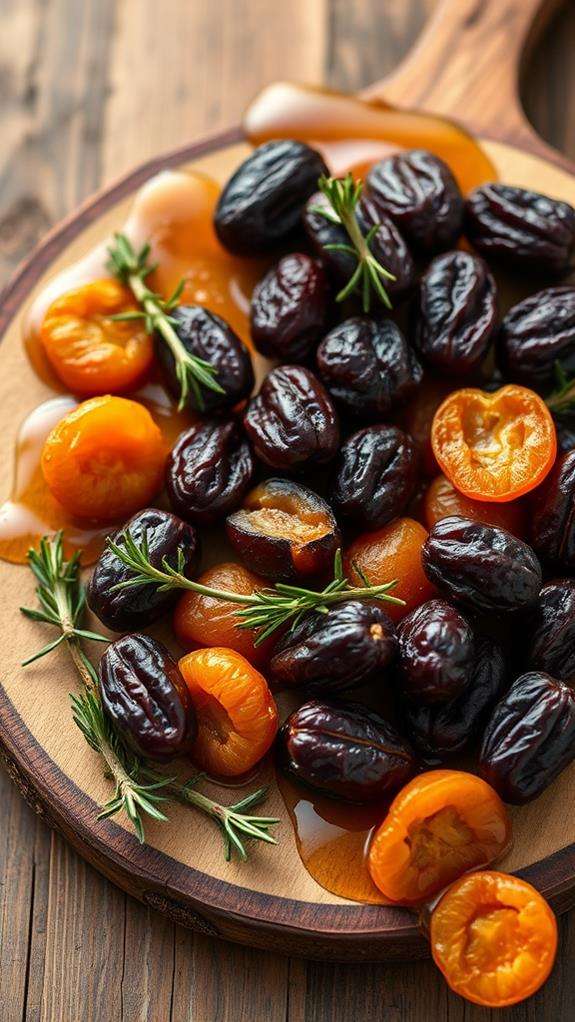
When you're adjusting recipes to use fig substitutes, you'll need to carefully balance moisture levels, especially with dried figs that contain considerably less water than fresh ones. You can achieve proper moisture content by soaking dried figs in warm water for 30 minutes before use, or by adding small amounts of liquid to your recipe as needed. Since dried figs pack more concentrated sweetness than fresh ones, you'll want to reduce the quantity to one-third less than called for in the original recipe, while also adjusting any additional sweeteners to maintain the intended flavor profile.
Moisture Balance When Substituting
Maintaining proper moisture balance stands as an important factor when substituting fresh figs in recipes. When you're working with dried figs as a replacement, you'll need to reduce the quantity by one-third since they're more concentrated in both flavor and sweetness. To achieve the right moisture content, you'll want to take into account several key adjustments in your recipe.
Here are the vital moisture-balancing techniques you should implement:
- Soak your dried figs in water for 20-30 minutes before use, allowing them to rehydrate and achieve a texture closer to fresh figs
- Add small amounts of water or fruit juice when using dried figs to compensate for moisture loss in the original recipe
- When using applesauce as a substitute, maintain a one-to-one ratio but reduce other liquid ingredients accordingly
If you're preparing dishes like salads or cheese platters where fresh figs are typically featured, roasted grapes can serve as an excellent alternative. They'll provide similar moisture content while contributing their own unique sweetness to the dish. Remember that each substitution requires careful attention to liquid ratios to maintain the recipe's intended consistency and texture.
Sweetness Level Modifications
The art of balancing sweetness levels requires careful attention when substituting fresh figs in recipes. When you're working with dried figs, you'll need to reduce the quantity by one-third of what the recipe calls for, as their concentrated sugars can easily overwhelm your dish. Similarly, if you're using Medjool dates as an alternative, you'll want to adjust the amount downward since they pack more sweetness than fresh figs.
For those opting to use fig jam, start with half the specified amount of fresh figs and adjust upward based on your taste preferences. You can effectively balance the heightened sweetness by adding a splash of citrus juice – lemon or lime works well here. Don't forget to evaluate other sweet ingredients in your recipe; you may need to reduce or eliminate additional sweeteners like honey or sugar to maintain the intended flavor profile. As you make these modifications, it's essential to taste-test throughout the cooking process, making incremental adjustments until you achieve the desired sweetness level. Remember, it's always easier to add more sweetness than to correct an overly sweet dish.
Frequently Asked Questions
What Fruit Is Similar to a Fig?
You'll find several fruits that share similar characteristics with figs. Medjool dates offer a comparable sweet, caramel-like flavor and chewy texture. Ripe pears can mimic figs' soft consistency and mild sweetness, while dried apricots provide that distinctive chewy texture with a sweet-tart taste. Fresh peaches are another excellent match, sharing figs' juicy nature and sweet profile. For the closest match, you can't go wrong with dried figs, which retain most of fresh figs' characteristics.
What Is a Good Substitute for Figs in a Salad?
Like finding the perfect dance partner, selecting a fig substitute for your salad requires careful consideration. You'll find that pears offer a similar mild sweetness and juicy texture, while black grapes, especially when roasted, provide that delightful burst of sweetness. If you're looking for alternatives, try chopped dried figs, crisp apple slices, or even roasted beets. Each option brings its own unique character while maintaining that sweet-savory balance you're aiming for.
Are Dried Figs the Same as Fresh Figs?
No, dried figs aren't the same as fresh figs in taste, texture, or nutritional content. You'll find dried figs are much sweeter and chewier due to their concentrated sugars and moisture loss during the drying process. They're also more calorie-dense and have higher fiber content than fresh figs. While fresh figs offer a delicate, subtle sweetness with a softer texture, dried figs deliver a more intense, earthy flavor and dense, chewy consistency.
Can You Use Dates in Place of Figs?
You're in luck – dates are a perfect stand-in for figs! You'll find they offer similar sweetness and texture, though they're actually a bit sweeter than figs. You can substitute one date for one fresh fig in most recipes, but you might want to use slightly less to balance the sweetness. For best results, chop your dates before adding them to your dish, as this helps them blend better with other ingredients.





